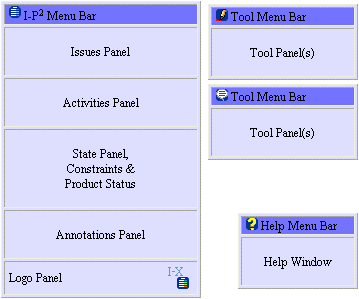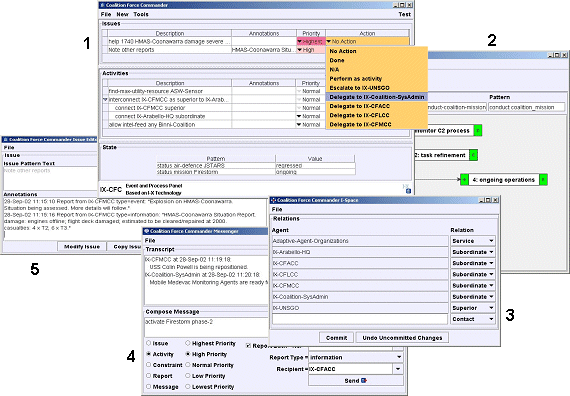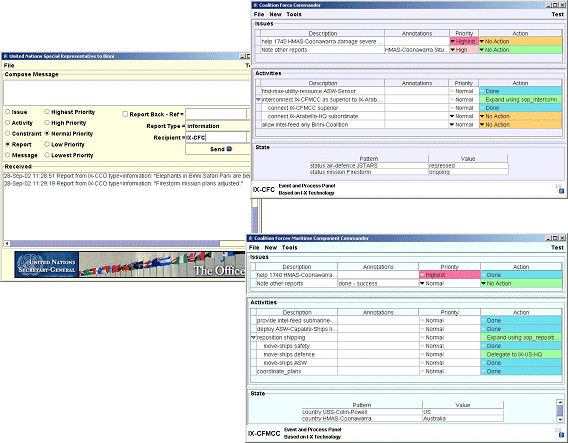I-X Process Panels - Technology Profile

I-X Process Panels - Technology Profile |
 |
Web homepage: http://i-x.info and http://www.aiai.ed.ac.uk/project/ix/
Developers: Austin Tate,
Jessica Chen-Burger, Jeff Dalton, Stephen Potter, Jussi Satder and
Gerhard Wickler
Organization: AIAI, The University of Edinburgh.
There is a need to coordinate people and systems to bring about more effective organisational behaviour; in the context of modern distributed, virtual organisations, when attempting any sort of collaborative synthesis task (such as design, planning or configuration), likely to require the capabilities of both human and computer agents, the need for such management becomes most evident.
The I-X suite of tools is intended to provide a well-founded approach to allow humans and computer systems to cooperate in the creation or modification of some product, be it a document, plan, design or physical entity. The principal interface to these tools, the I-X Process Panel, (I-P2) can be seen, at its simplest, as an intelligent 'to-do' list for its user; however, and especially when used in conjunction with other users' Panels, it can become a workflow, reporting and messaging 'catch all', allowing the coordination of activity, and hence facilitating more successful and efficient collaborations.
A Panel can take ANY requirement to:
These requirements can be handled via:
I-X reports and messages can be generated and sent, and the
receiving Panel will interpret these communications, where possible, so
as to:
Since it is unrealistic to expect any one participant to have access
to full knowledge of the state of the current process during a
collaborative episode, I-X tools are expressly intended to operate in
situations in which only partial knowledge from a particular perspective
is available to a user.

<I-N-C-A> Model
An I-X Process Panel supports a user or collaborative users in
selecting and carrying out "processes" and creating or modifying
"process products". Both processes and process products are abstractly
considered to be made up of "Nodes" (activities in a process, or parts
of a process product) which may have parts called sub-nodes making up a
hierarchical description of the process or product. The nodes are
related by a set of detailed "Constraints" of various kinds. A set of
"Issues" is associated with the processes or process products to
represent unsatisfied requirements, problems raised as a result of
analysis or critiquing, etc. Processes and process products in I-X are
represented in the <I-N-C-A> (Issues - Nodes - Constraints -
Annotations) Model of Synthesised Artifacts.
I-X Tools
As well as the Process Panel itself, a number of additional tools are
provided, accessed via a tools menu or through context dependent action
menus. These include:

The current release and documentation is available via
http://i-x.info/release/current/
(Version 2.4 onwards runs over Jabber without further
software or tailoring.)
Technical requirements: Windows NT/2000/XP or Unix/Linux/MacOS X,
Java Runtime Environment 1.3/1.4 (1.4-only planned from mid-2003).

Potter, S., Tate, A. and Wickler, G. (2006) Using I-X Process Panels as Intelligent To-Do Lists for Agent Coordination in Emergency Response, Proceedings of the Information Systems for Crisis Response and Management 2006 (ISCRAM2006), Special Session on "Multiagent Systems for Disaster Management and Response", Newark, New Jersey, USA, May 15-17, 2006. http://www.aiai.ed.ac.uk/project/ix/documents/2006/2006-iscram-potter-ix-eresponse.pdf
Tate, A. (2006) The Helpful Environment, Special Issue on Next 50 Years of Intelligent Systems, IEEE Intelligent Systems. Computer Society. http://i-x.info/documents/2006/2006-ieee-is-tate-helpful-environment.pdf